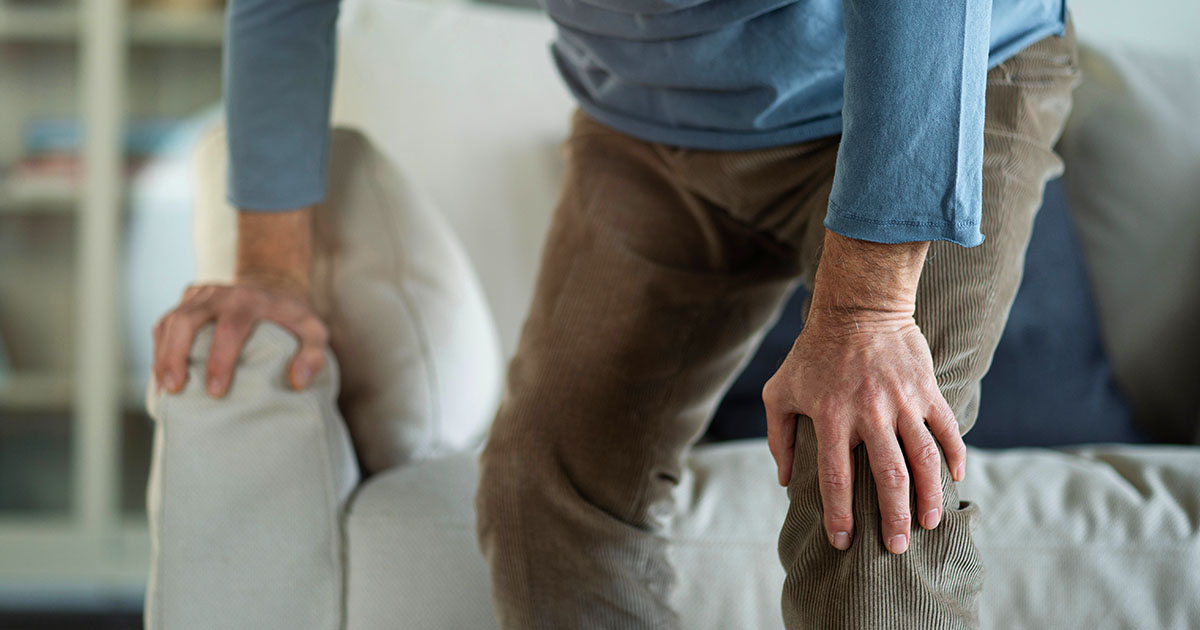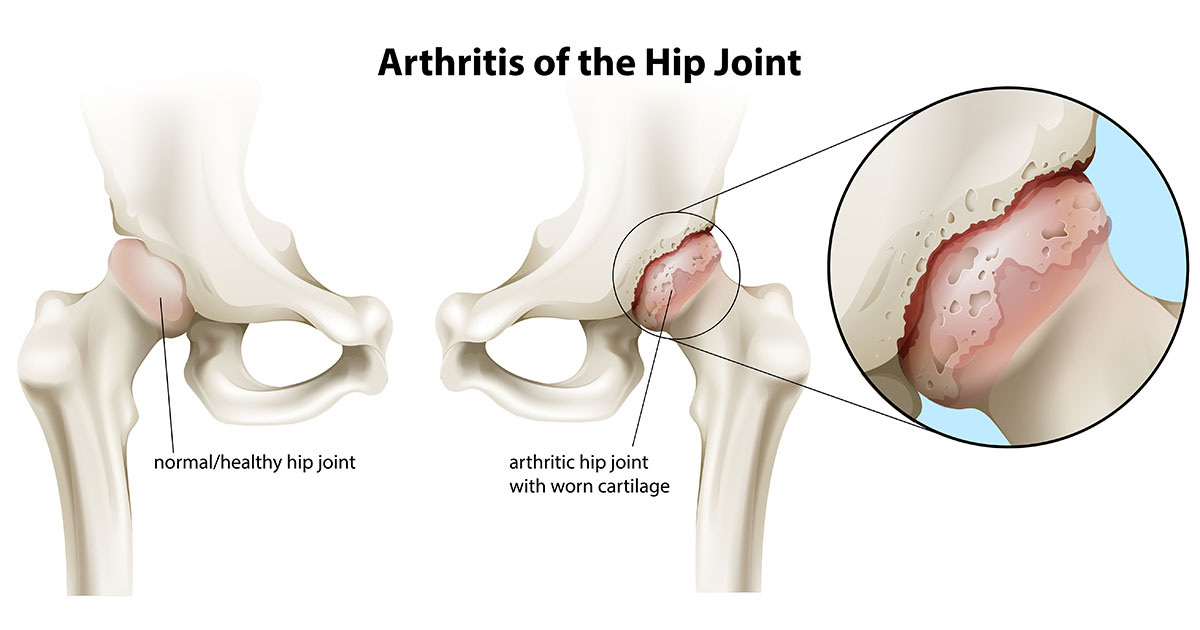What is Osteoarthritis? Get Answers to Your OA Questions

Maybe your daily run is more painful than before. Maybe your knees are swollen at the end of the day. Or perhaps you hear popping and cracking when you use your joints. You’re now talking to your doctor, who says you have osteoarthritis.
But what is osteoarthritis? What causes it? And most importantly, what can you do to treat it?
What is Osteoarthritis (OA)?
Osteoarthritis (OA) is the most common form of arthritis. It’s sometimes referred to as “wear-and-tear” arthritis and affects millions of people around the world. It occurs when the protective cartilage that covers the ends of bones wears away over time to become frayed and rough. Normal cartilage is a firm, slippery tissue that makes joint motion frictionless. When that cartilage breaks down, patients experience a range of uncomfortable symptoms due to friction.
Though it can affect any joint, it’s most commonly found in the joints of the hands, knees, hips, and spine. And although osteoarthritis primarily impacts cartilage, it also affects the entire joint by causing:
- Bone changes
- Weakening of the tissue that holds joints together and attaches muscle to bone
- Swelling of the joint lining
What Does Osteoarthritis Look Like?


When osteoarthritis affects joints, cartilage breaks down, and bone spurs can form. Bone spurs are extra pieces of bone that develop and can feel like hard lumps. Eventually, if the cartilage breaks down enough, bone will rub against bone.
Symptoms of Osteoarthritis
Luckily, symptoms of osteoarthritis usually develop slowly with time. However, it’s important to pay attention to your body and keep in touch with your doctor as symptoms appear.
- Pain
- Stiffness
- Tenderness
- Loss of flexibility/limited range of motion
- Grating sensation
- Bone spurs
- Swelling
It’s essential to see an osteoarthritis doctor if joint pain, stiffness, and swelling don’t go away and start to impact your daily activities.
Risk Factors for Osteoarthritis
Some people may be more susceptible to developing osteoarthritis, including:
- Old age: The risk of OA increases with age
- Sex assigned at birth: People assigned female at birth are more likely to develop OA, though it isn’t clear why
- Obesity: Increased weight adds stress to joints
- Joint injuries: Former injuries (like sports injuries) can increase the risk of OA
- Genetics: Some people inherit a higher risk of developing OA
- Bone deformities: Some people are born with malformed joints or flawed cartilage
- Metabolic diseases: Those with diabetes or hemochromatosis (a disorder where the body has too much iron) may have a higher risk of OA
How Osteoarthritis is Diagnosed
During a physical exam, your doctor (usually a rheumatologist) will take a look at your affected joint(s) to check for tenderness, swelling, and flexibility. You may also receive:
- Imaging tests:
- Imaging like X-rays and MRIs can see changes in the spaces between joints, bone spurs, the condition of soft tissues, and more
- These imaging tests help your doctor properly diagnose your condition, i.e., osteoarthritis
- Lab tests: Analyzing blood and/or joint fluid can help rule out other causes of joint pain, like rheumatoid arthritis, gout, or infection.
Other Types of Arthritis
Rheumatoid Arthritis (RA)
RA is a chronic condition that causes pain, swelling, and irritation in the joints, usually affecting the hand, foot, elbow, knee, or ankle joints. RA is an autoimmune condition; autoimmune diseases are health conditions that happen when your immune system attacks your body instead of defending it. Osteoarthritis, for reference, is not an autoimmune condition—instead, it’s related to the overuse of joints.
Fortunately, new medications have expanded the treatment options rheumatologists can use to help relieve symptoms of rheumatoid arthritis. Treatment can even put RA in remission.
Juvenile Arthritis (JIA)
Juvenile idiopathic arthritis, formerly known as juvenile rheumatoid arthritis, is the most common type of arthritis in children under 16. Some kids experience symptoms like joint pain, swelling, and stiffness for only a few months, but other children have symptoms for years. Rheumatologists use a combination of treatments to help those with juvenile arthritis, including medications and physical therapy.
Gout
Gout is a type of inflammatory arthritis that causes intense pain, redness, warmth, and swelling in the joints, usually occurring as a flare-up for about 1-2 weeks before subsiding. It’s often preventable with a combination of diagnosis, treatment, and lifestyle changes. If you experience symptoms of gout, a rheumatologist can help you establish a self-care plan to help avoid future attacks.
Osteoarthritis Treatments
After being diagnosed with OA, your rheumatology doctor will go through several treatment options with you based on your medical history and the severity of your arthritis. In most cases, they will recommend nonsurgical treatments to start. If needed, they will consult with an orthopedic surgeon about other treatment options that might be most effective.
If you’re wondering about the difference between an orthopedic surgeon and a rheumatologist, you’re not alone. While these specialties overlap—especially in treating osteoarthritis—they have distinct focuses. Rheumatologists primarily focus on diagnosing conditions, nonsurgical treatments, lifestyle therapies, and medications. Orthopedic surgeons, in contrast, primarily explore nonsurgical treatments like physical therapy as well as surgical treatments like joint replacement.
We talked with an OSMS orthopedic surgeon, Dr. Walker Flannery, about some of these nonsurgical methods to better understand how they help relieve the symptoms of osteoarthritis.
Medications
One of the simplest ways to help relieve the pain, stiffness, and swelling from arthritis is to take over-the-counter medications such as:
- Ibuprofen (Advil): Max dose of 2400 mg per day, split into three equal doses
- Naproxen (Aleve): Max dose of 880 mg per day, split into two equal doses
- Acetaminophen (Tylenol): Max dose of 3000 mg per day, split into three equal doses
“These over-the-counter medications not only help relieve pain, but many will actually reduce inflammation within the joint,” says Dr. Flannery.
Note: Please consult with your primary care physician before taking any of the above medications.

Lifestyle Changes
In addition to over-the-counter medications, there are many lifestyle changes that a person can make to help with joint pain and other OA symptoms. These include:
- Staying active, but switching to lower-impact activities like walking, biking, swimming, and yoga
- Maintaining a healthy weight to reduce the pressure put on joints like the knees and hips
- Using an assistive device such as a cane or walking stick
- Eating certain foods, like cruciferous vegetables (broccoli, Brussels sprouts, cabbage), may slow cartilage damage in joints caused by OA
Physical Therapy
As Dr. Flannery shares, physical therapy helps maintain or increase the range of motion within the joint. It also builds muscle strength, which may help relieve any extra pressure being put on the joint. Doing physical therapy at this stage of OA (prior to surgery) can also help with recovery and the overall outcome if joint replacement surgery is eventually needed.
Injections
Another nonsurgical option for arthritis management is joint injections. This treatment method is used to deliver medication directly into the arthritic joint to reduce inflammation and relieve pain. One type is a cortisone (steroid) injection that reduces inflammation within a joint, which can significantly reduce pain. A second type of injection uses a solution that lubricates the joint to reduce pain and improve range of motion and mobility within the joint.
Dr. Flannery shares that any of these nonsurgical methods can be used for arthritis in the hips, knees, shoulders, or other joints. At OSMS, our goal with recommending these options is to relieve patient symptoms and see if surgery can be delayed or even prevented. It’s also important to note that many insurance plans require patients to try nonsurgical methods prior to having joint replacement surgery if they are looking to have the procedure covered by insurance.
Experiencing Joint Pain? Be Seen By An Osteoarthritis Specialist Today—Without a Referral*

To make an appointment with Dr. Flannery or any of the other OSMS osteoarthritis specialists, schedule an appointment or call 920-430-8113
*Most insurance plans do not require a referral to come to OSMS for care.
This post was originally published in October of 2018 but updated and republished August 19, 2025.










